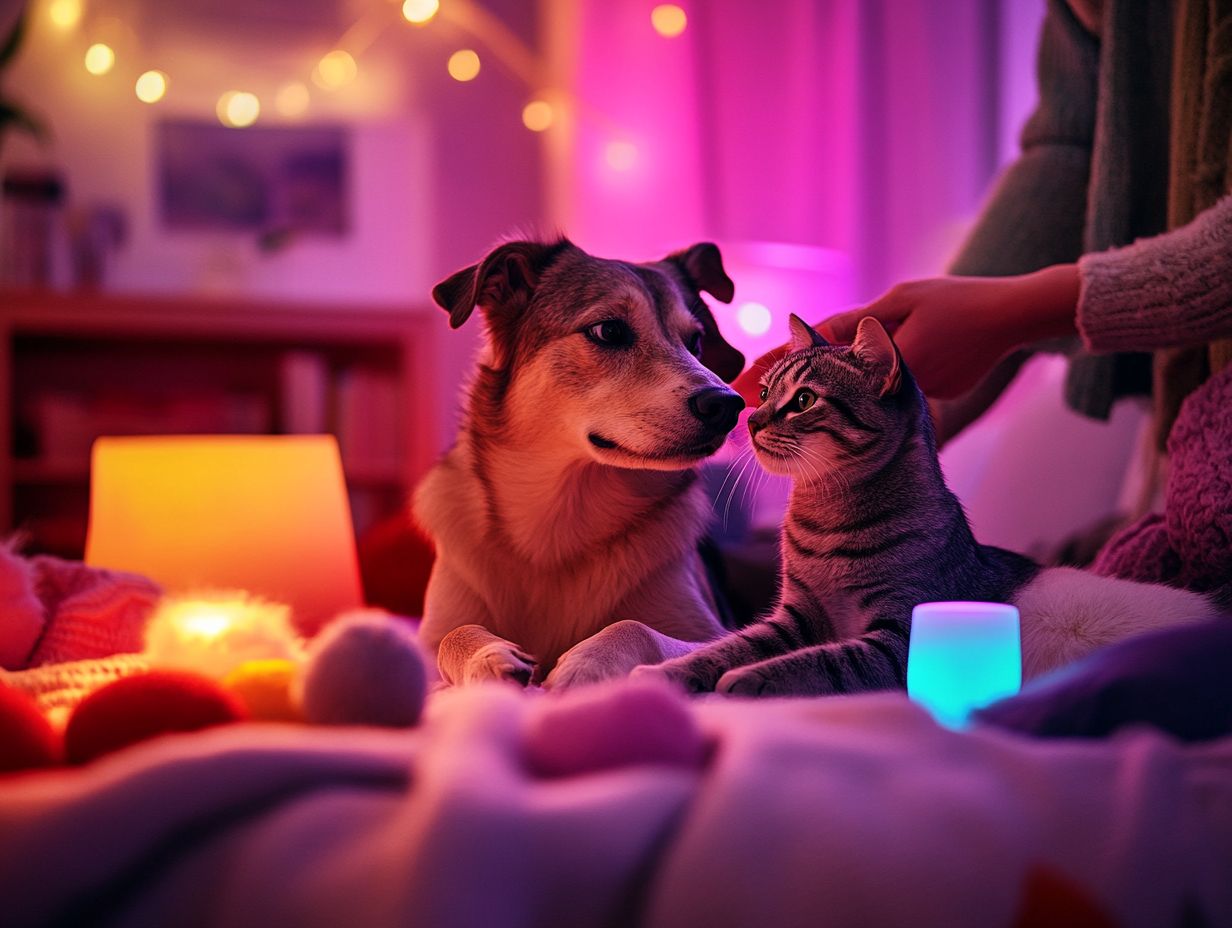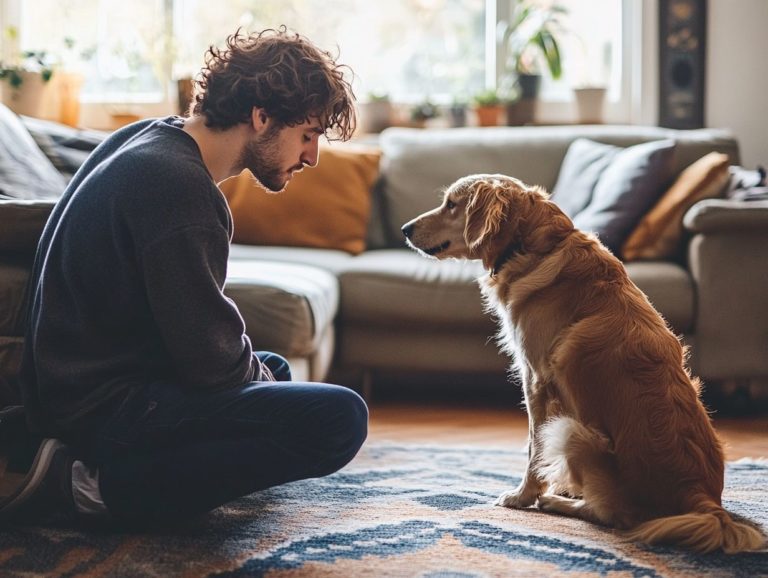Socialization Techniques for Anxious Pets
Understanding pet anxiety is essential for you as a dog owner who wants to ensure that your furry friend lives a happy, fulfilling life, whether they are a German Shepherd, Labrador Retriever, Cocker Spaniel, or Australian Shepherd.
This article delves into the various causes and symptoms of anxiety in pets. It highlights the importance of socialization as a powerful tool for alleviating their anxiety and fearful behavior.
From creating a secure environment to employing effective techniques like gradual exposure and positive reinforcement, you ll discover everything you need to help your anxious dog flourish!
You ll also find valuable tips for managing setbacks and ensuring long-term success in socialization. Together, you can create a more comfortable world for your anxious dogs and puppies!
Contents
- Key Takeaways:
- Understanding Pet Anxiety
- Importance of Socialization for Anxious Pets
- Preparing for Socialization
- Techniques for Socializing Anxious Pets
- Dealing with Setbacks and Challenges
- Maintaining Socialization for Long-Term Success
- Frequently Asked Questions
- What makes socialization so crucial for anxious pets?
- Which pets can benefit from socialization techniques?
- What are some signs that my pet may be anxious?
- What are some common socialization techniques for anxious pets?
- Can I socialize my pet if they have had negative experiences in the past?
- Are there any risks involved in socializing anxious pets?
Key Takeaways:

- Socialization is crucial for anxious pets, including fearful dogs, as it helps them overcome fears and develop confidence.
- Gradual exposure and positive reinforcement are effective techniques for socializing anxious dogs and reducing fearful behavior.
- Creating a safe and comfortable environment, introducing them to new people and animals, and using calming aids, such as CBD, can also aid in the process.
Understanding Pet Anxiety
Understanding pet anxiety is essential for dog owners, particularly when it comes to identifying the signs of fearful dogs and assisting them in managing their emotional responses. Anxiety in dogs can present itself in numerous ways, often manifesting as fearful behavior that may arise from genetic predisposition, insufficient socialization, or past trauma.
By keenly observing a dog s body language and emotional responses, you can more effectively address the needs of anxious dogs and apply appropriate dog training techniques. Creating a happy and healthy environment for your furry companions is vital for nurturing their overall well-being.
Causes and Symptoms
The causes and symptoms of pet anxiety can vary significantly, often stemming from a mix of genetic predisposition and environmental influences that contribute to fearful behavior and anxiety.
Consider a dog s upbringing; if they haven t been properly socialized during critical developmental phases, you might see them becoming increasingly anxious in unfamiliar situations or around new people, leading to fearful behavior.
Traumatic experiences, like abuse or exposure to loud noises, can also lead to distress, which may manifest as excessive barking, aggression towards others, or even complete withdrawal from social interactions, further complicating dog behavior.
Given these complexities, it s crucial for you as a dog owner to consult a veterinary behaviorist or an organization like the Animal Humane Society for guidance. They can provide a tailored diagnosis and effective treatment plans to help alleviate anxiety and enhance your pet s overall well-being.
Importance of Socialization for Anxious Pets
Socialization can make a world of difference for your anxious pet; let’s explore how! It provides them with the opportunity to engage with a variety of stimuli, including other dogs, puppies, and people, which is essential for alleviating fear and anxiety. Utilizing techniques for building a bond with anxious pets can further enhance this process.
Participating in activities at dog parks, such as those offered by Reactive Rovers, and daycare can serve as excellent avenues for gradual exposure to new environments. This ultimately enhances your dog s social skills and diminishes fearful behavior over time.
Use positive reinforcement during training and social interactions to guide your pet in navigating their emotional responses more effectively, fostering a more confident and relaxed companion.
Benefits and Potential Risks
Socialization provides a wealth of benefits for anxious dogs, including improved emotional responses, enhanced confidence, and better behavior through effective training techniques. For those looking for practical advice, tips for training anxious pets at home can be invaluable. However, it’s essential to approach this delicate process thoughtfully, considering the social distance and emotional responses, to avoid potential risks.
Engaging in socialization can significantly reduce anxiety levels and fearful behavior, enabling your dog to navigate various environments with newfound ease. Understanding the science behind training anxious pets highlights how positive interactions with other dogs and new people foster trust and encourage more relaxed behavior in public settings.
It s vital to be aware that overwhelming your anxious dog with too many stimuli can lead to increased stress and reinforce fearful behavior, complicating their training. To prevent this, consider a gradual exposure strategy, slowly introducing your dog to new experiences in controlled environments, such as dog parks.
By closely monitoring these interactions, you can promptly address any signs of discomfort or anxiety, ensuring that the socialization process remains both safe and effective.
Preparing for Socialization

Preparing for socialization is an essential step for any dog owner, including those with fearful dogs. Creating a safe and comfortable environment can greatly impact your dog’s ability to adapt and minimize anxiety.
By adopting a structured approach, one that includes gradual exposure to new experiences and techniques to calm anxious pets before training, you can enhance the socialization process for your fearful dog.
This thoughtful preparation lays the groundwork for positive interactions, enabling anxious dogs to gain confidence and thrive in diverse environments.
Creating a Safe and Comfortable Environment
A safe and cozy environment is key to successful socialization! Creating a safe and comfortable environment is vital for the socialization process, as it allows anxious dogs to feel secure and receptive to new experiences and training.
To accomplish this, you can begin by designing your home and outdoor spaces with specific spots that are free from clutter and distractions, letting your dogs explore without fear. Enhance your indoor spaces with cozy corners that provide a sense of retreat.
Ensure your outdoor areas include secure zones where your dog can interact with other friendly pets and new animals under your watchful eye.
Utilizing positive reinforcement training techniques, such as rewarding calm behavior during encounters with new stimuli, can significantly boost their comfort levels and foster a positive attitude toward socialization in dogs. For more strategies, check out these techniques to help pets adjust to new environments. As your dog learns to associate new experiences with rewards, their anxiety will diminish, paving the way for healthier interactions and improved dog behavior.
Techniques for Socializing Anxious Pets
Use effective techniques like counter conditioning to help anxious pets reduce their fears and improve their behavior. Approaches like counter conditioning and positive reinforcement can work wonders in easing their fears.
Gradual Exposure and Positive Reinforcement
Gradual exposure and positive reinforcement are two highly effective training techniques for helping your fearful dog overcome anxiety and develop better social skills. For more detailed strategies, check out techniques to train pets with fear of strangers.
By introducing new experiences in small, manageable steps, you can significantly reduce your canine companion’s stress levels and fearful behavior. For instance, if your dog is fearful of loud noises, you might start by playing a recording of soft sounds at a low volume, gradually increasing the volume as they become more comfortable. During this process, using positive reinforcement like treats or praise is essential for encouraging good behavior in your dog.
When your dog displays calm behavior, rewarding them reinforces that they ve successfully navigated a challenging situation, helping to build their confidence. A practical scenario could involve introducing your dog to unfamiliar people and other animals in a controlled environment.
Initially, keep interactions brief and reward your dog for approaching without fear, using positive reinforcement to encourage trust. This approach helps build their confidence over time, as they learn to feel secure in new situations.
Start today, and watch your pup thrive in new situations!
Counter conditioning means changing your dog’s emotional response to a stimulus by pairing it with something positive, like treats.
Introducing New People and Animals
Introducing anxious dogs to new people and animals demands a thoughtful strategy to ensure positive interactions and mitigate fear responses. It’s essential to emphasize social distance.
Start by creating controlled environments for these introductions, such as dog parks, daycares, or serene backyards. The right location can dramatically impact how your anxious dog reacts. Always prioritize safety to ensure a sense of security.
Pay close attention to your canine companion, noting any signs of discomfort or stress like cowering, barking, or excessive tail tucking to gauge their emotional response.
Gradually introduce new individuals, allowing your dog to approach at their own pace while monitoring their body language and emotional reactions. This method can significantly bolster their confidence and comfort in social situations.
Remember, building positive associations with new experiences takes time and understanding. Patience is crucial in this journey.
Using Calming Aids and Techniques

As a dog owner, you can explore a variety of calming aids and techniques to help ease your pet’s anxiety during socialization. Natural options include CBD, anxiety wraps, and stress management tools.
Calming aids provide a crucial function in creating a serene environment for your dog. They enable your pet to feel more at ease in situations that typically trigger anxiety. For instance, CBD oil is a natural oil that can help dogs relax without the intoxicating effects of some other treatments, making it a popular choice among pet owners.
Anxiety wraps, which gently hug your dog to provide comfort, can soothe your nervous pup during stressful situations. Additionally, pheromone diffusers release comforting scents that mimic natural pheromones, further encouraging tranquility and reducing anxious behaviors.
When combined with appropriate training and socialization practices, these resources not only help alleviate anxiety but also enhance your pet s overall experience. This paves the way for happier interactions and improved dog behavior.
Dealing with Setbacks and Challenges
Navigating setbacks and challenges is an unavoidable aspect of being a dog owner striving to support your anxious pet through effective training and socialization. By recognizing these obstacles, you can develop effective strategies for managing anxiety levels and providing comfort to your fearful dog.
Common Challenges and How to Overcome Them
Common challenges during socialization may include unexpected fearful behaviors, resistance to new environments, and struggles in maintaining calm during interactions.
These issues can manifest as growling, retreating, or even displaying signs of aggression in unfamiliar situations. To effectively tackle these challenges, take the time to understand your pet s unique triggers and responses, creating a safe space where they feel secure.
Gradual exposure to new environments can be beneficial. Start with low-stress scenarios and slowly increase complexity as your dog s comfort levels rise. Employing positive reinforcement techniques encourages the desired behaviors while managing your expectations.
Consistency, patience, and adaptability in your dog training approach will ensure that your furry companion gradually becomes more social and less fearful. This leads to a rewarding relationship for both of you.
Maintaining Socialization for Long-Term Success
For dog owners striving for long-term success, maintaining socialization is crucial to ensuring that your pet remains well-adjusted and confident in various environments. It s not just about the occasional trip to the park; it s about fostering a lifestyle where your dog feels comfortable and secure in any situation.
Tips for Continued Socialization and Management of Anxiety
To effectively manage anxiety and encourage ongoing socialization for your dog, you can adopt a range of practical strategies. These strategies create enriching experiences for your pet, ultimately enhancing their dog behavior.
Establishing a consistent routine is essential. It provides your dog with a sense of security and helps them anticipate their daily activities.
Keeping interactions low-stress is equally vital. Gradually introducing new environments or other dogs can help prevent overwhelming feelings.
Recognizing and celebrating small victories like a calm encounter with another dog or a successful stroll in a new area can significantly enhance your dog s confidence.
These efforts foster positive connections with others and promote a relaxed and self-assured demeanor in social situations. This ultimately leads to more joyful interactions.
Frequently Asked Questions

Socialization is the process of exposing pets to different people, animals, and environments in a positive and controlled manner. It helps anxious pets build confidence, reduce fear and anxiety, and learn training techniques to manage aggression towards unfamiliar situations.
All pets, regardless of age or breed, can benefit from socialization techniques. It is particularly beneficial for anxious pets, such as rescue animals and shy or fearful dogs. For those looking for effective methods, exploring training techniques specifically for anxious breeds can make a significant difference, especially for pets who have had little exposure to the outside world.
What are some signs that my pet may be anxious?
Signs of anxiety in pets can include excessive barking or meowing, hiding, destructive behavior, shaking or trembling, and aggression towards people or other animals. Each pet may show unique signs of anxiety, so it’s important to pay attention to their behavior.
If you have concerns, consult with a veterinarian.
Common socialization techniques for anxious pets include gradual exposure to new people and environments, along with positive reinforcement training. Understanding the importance of socialization for anxious pets can also help you use techniques to get your pet used to things that make them anxious.
It’s important to work with a professional trainer or behaviorist to determine the best approach for your specific pet.
Yes, it is possible to socialize a pet who has had negative experiences in the past. It may require a different approach and take more time and patience.
With proper guidance and training, most pets can overcome their fears and become more comfortable in new situations.
Socialization should always be done in a safe and controlled manner with the guidance of a professional. There is a risk of triggering anxiety or fear in some pets, so keep a close watch on your pet’s behavior. To help ease their concerns, consider using techniques for training anxious senior pets; it’s crucial for their happiness!
Adjust the socialization techniques as needed to ensure their well-being.
Start socializing your pet today for a happier, more confident companion!






